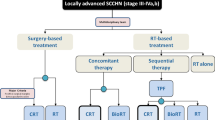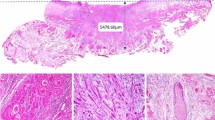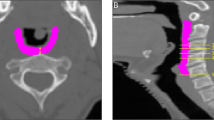Abstract
Purpose
We aimed to analyze the oncological and functional outcomes of chemoradiation for T4 laryngeal and hypopharyngeal cancer.
Methods
Patients treated between 2008 and 2015 with chemoradiation (n = 39) were retrospectively analyzed for oncological and functional (laryngo-esophageal dysfunction-free survival, LED-FS) outcomes and compared with 32 consecutive patients treated primarily with total laryngectomy (TL). LED was scored as event in case of local failure, TL for any reason, persistent tracheotomy and/or feeding tube dependency 2 years after chemoradiation.
Results
The 5-year local control (LC) rates in the chemoradiation and TL groups were 64 and 87%, respectively (p = 0.030). The disease-free survival was 54 and 59% (p = 0.810), and overall survival (OS) was 46 and 47% (p = 1.00). In the chemoradiation group, the 5-year cumulative incidence of LED-FS was 46%, but was significantly worse in patients with poor pre-treatment laryngeal function, compared to those without (20% and 74%, respectively, p = 0.001). Furthermore, patients with LED have significantly worse OS compared to those without (32% and 65%, respectively, p = 0.041). Multivariate analysis showed that primary treatment type is significantly predictive for LC, while tumor site and extra-capsular extension were predictive for OS. Poor pre-treatment laryngeal function is the only significant predictive factor for LED.
Conclusions
TL resulted in significantly better LC, as compared to chemoradiation in T4 laryngeal and hypopharyngeal cancer patients and the LED-FS is worse in patients with poor pre-treatment laryngeal function. These patients might benefit more from primary treatment with TL followed by radiotherapy. These issues should be taken into consideration, as patients are counseled about different primary treatment options.



Similar content being viewed by others
References
The Department of Veterans Affairs Laryngeal Cancer Study Group (1991) Induction chemotherapy plus radiation compared with surgery plus radiation in patients with advanced laryngeal cancer. N Engl J Med 349:1685–1690
Lefebvre JL, Chevalier D, Luboinski B, Kirkpatrick A, Collette L, Sahmoud T (1996) Larynx preservation in pyriform sinus cancer: preliminary results of a European Organization for Research and Treatment of Cancer phase III trial. EORTC Head and Neck Cancer Cooperative Group. J Natl Cancer Inst 88:890–899
Forastiere AA, Zhang Q, Weber RS, Maor MH, Goepfert H, Pajak TF et al (2013) Long-term results of RTOG 91-11: a comparison of three nonsurgical treatment strategies to preserve the larynx in patients with locally advanced larynx cancer. J Clin Oncol 31:845–852
Adelstein DJ, Li Y, Adams GL, Wagner H Jr, Kish JA et al (2003) An intergroup phase III comparison of standard radi- ation therapy and two schedules of concurrent chemoradiotherapy in patients with unresectable squamous cell head and neck cancer. J Clin Oncol 21:92–98
Vokes EE, Kies MS, Haraf DJ, Stenson K, List M, Humerickhouse R et al (2000) Concomitant chemoradiotherapy as primary therapy for locoregionally advanced head and neck cancer. J Clin Oncol 18:1652–1661
Altundag O, Gullu I, Altundag K, Yalcin S, Ozyar E, Cengiz M et al (2005) Induction chemotherapy with cisplatin and 5-fluorouracil followed by chemoradiotherapy or radiotherapy alone in the treatment of locoregionally advanced resectable cancers of the larynx and hypopharynx: results of single-center study of 45 patients. Head Neck 27:15–21
Shin DM, Glisson BS, Khuri FR, Lippman SM, Ginsberg L, Diaz E Jr et al (2002) Phase II study of induction chemotherapy with paclitaxel, ifosfamide, and carboplatin (TIC) for patients with locally advanced squamous cell carcinoma of the head and neck. Cancer 95:322–330
Grover S, Swisher-McClure S, Mitra N, Li J, Cohen RB, Ahn PH et al (2015) Total Laryngectomy versus larynx preservation for T4a larynx cancer: patterns of care and survival outcomes. Int J Radiat Oncol Biol Phys 92:594–601
Forastiere AA, Ismaila N, Lewin JS, Nathan CA, Adelstein DJ, Eisbruch A et al (2018) Use of larynx-preservation strategies in the treatment of laryngeal cancer: American Society of Clinical Oncology Clinical Practice Guideline Update. J Clin Oncol 36:1143–1169
Tennant PA, Cash E, Bumpous JM, Potts KL (2014) Persistent tracheostomy after primary chemoradiation for advanced laryngeal or hypopharyngeal cancer. Head Neck 36:1628–1633
Jefferson GD, Wenig BL, Spiotto MT (2016) Predictors and outcomes for chronic tracheostomy after chemoradiation for advanced laryngohypopharyngeal cancer. Laryngoscope 126:385–391
Byrd SA, Xu MJ, cass LM, Wehrmann DJ, Naunheim M, Christopher K et al (2018) Oncologic and functional outcomes of pretreatment tracheotomy in advanced laryngeal squamous cell carcinoma: a multi-institutional analysis. Oral Oncol 78:171–176
Tulunay-Ugur OE, McClinton C, Young Z, Penagaricano JA, Maddox AM, Vural E (2013) Functional outcomes of chemoradiation in patients with head and neck cancer. Otolaryngol Head Neck Surg 148:64–68
Staton J, Robbins KT, Newman L, Samant S, Sebelik M, Vieira F (2002) Factors predictive of poor functional outcome after chemoradiation for advanced laryngeal cancer. Otolaryngol Head Neck Surg 127:43–47
van der Voet JC, Keus RB, Hart AA, Hilgers FJ, Bartelink H (1998) The impact of treatment time and smoking on local control and complications in T1 glottic cancer. Int J Radiat Oncol Biol Phys 42:247–255
Mak-Kregar S, Schouwenburg PF, Baris G, Hilgers FJ, Hart AA (1992) Staging and prognostic factors in carcinoma of the base of the tongue. Clin Otolaryngol Allied Sci 17:107–112
Al-Mamgani A, van Rooij PH, Mehilal R, Verduijn GM, Tans L, Kwa SL (2014) Radiotherapy for T1a glottic cancer: the influence of smoking cessation and fractionation schedule of radiotherapy. Eur Arch Otorhinolaryngol 271:125–132
Mendenhall WM, Parsons JT, Mancuso AA, Pameijer FJ, Stringer SP, Cassisi NJ (1997) Definitive radiotherapy for T3 squamous cell carcinoma of the glottic larynx. J Clin Oncol 15:2394–2402
MacKenzie R, Franssen E, Balogh J, Birt D, Gilbert R (1998) The prognostic significance of tracheostomy in carcinoma of the larynx treated with radiotherapy and surgery for salvage. Int J Radiat Oncol Biol Phys 41:43–51
Schariatzadeh R, Pezier TF, Studer G, Schmid S, Huber GF (2015) Does airway intervention before primary nonsurgical therapy for T3/T4 laryngeal squamous cell carcinoma impact on oncological or functional outcomes? Swiss Med Wkly 145:w14213
Terrell JE, Ronis DL, Fowler KE, Bradford CR, Chepeha DB, Prince ME et al (2004) Clinical predictors of quality of life in patients with head and neck cancer. Arch Otolaryngol Head Neck Surg 4:401–418
Hanna E, Sherman A, Cash D, Adams D, Vural E, Fan CY et al (2004) Quality of life for patients following total laryngectomy vs chemoradiation for laryngeal preservation. Arch Otolaryngol Head Neck Surg 130:875–879
Trivedi NP, Swaminathan DK, Thankappan K, Chatni S, Kuriakose MA, Lyer S (2008) Comparison of quality of life in advanced laryngeal cancer patients after concurrent chemoradiation vs total laryngectomy. Otolariyngol Head Neck Surg 139:702–707
Funding
None of the authors have received any funding.
Author information
Authors and Affiliations
Corresponding author
Ethics declarations
Conflict of interest
All authors declare no conflict of interest.
Ethical approval
This article does not contain any experimental study with human participants performed by any of the authors. For this type of work, formal consent is not required due to its retrospective nature.
Rights and permissions
About this article
Cite this article
Al-Mamgani, A., Navran, A., Walraven, I. et al. Organ-preservation (chemo)radiotherapy for T4 laryngeal and hypopharyngeal cancer: is the effort worth?. Eur Arch Otorhinolaryngol 276, 575–583 (2019). https://doi.org/10.1007/s00405-018-5241-8
Received:
Accepted:
Published:
Issue Date:
DOI: https://doi.org/10.1007/s00405-018-5241-8




